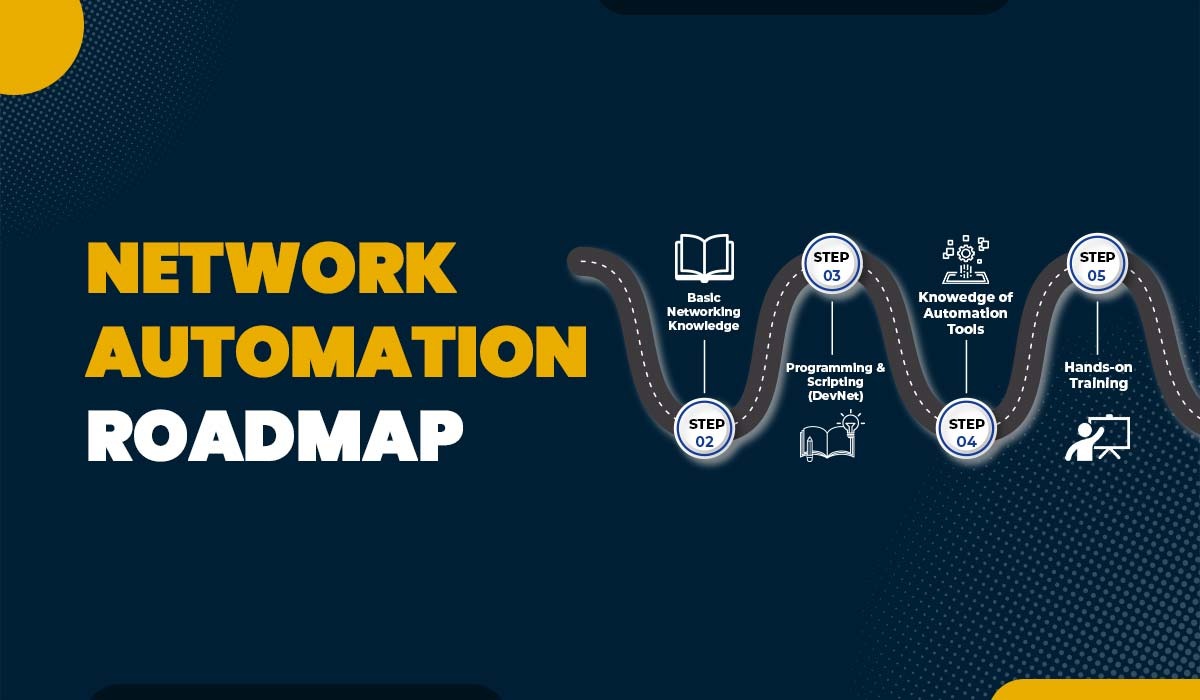Introduction
Networks are becoming more and more complex with time, and to handle these networks, network automation is the next step forward. Whether you are a network enthusiast eager to explore new skills, a beginner taking your first steps, or a professional looking to optimize your network operations, this blog is just for you. Today, we will discuss the network automation roadmap, where we look into some of the steps that you can follow to learn regardless of your current skill level, best practices, challenges, tools, and resources. We will try to clear doubts regarding the most asked question, “How to learn Network Automation?”
Before getting into the network automation roadmap, let us understand what network automation really is. If you are serious about mastering automation, enrolling in a network automation course can be a great way to gain structured knowledge and hands-on experience.
What is Network Automation?
In simplest terms, network automation is the process of using software, scripts, and tools to manage, configure, test, and monitor network devices and operations without human intervention. Traditionally, network management involves manually configuring routers, switches, and firewalls—a practice both time-consuming and error-prone.
Network automation, however, allows for tasks such as device configuration, change management, monitoring, and security checks to be executed automatically.
But why do you have to learn network automation? Let us discuss this in detail before getting into the network automation roadmap.
Why Learn Network Automation?
There are multiple reasons why you should focus on learning network automation skillset. Some of these are:
The Growing Demand for Automation in Networking
Day after day, the complexity of networks is increasing. Therefore, network automation is becoming very popular and is being implemented by many to help with faster and more accurate operations. The incorporation of automation in different industries is rapidly increasing with common network automation use cases, including network automation in configuration, testing, monitoring, deploying, and troubleshooting. This is opening up numerous opportunities for professionals with proficiency in automation.
Scalability in a Growing World
While the organizations are growing and the networks are more complex, the manual methods are no longer suitable. With the help of automation tools, large networks can be controlled more centrally with numerous operation procedures so that the addition of new devices or protocols can further be incorporated.
The Role of Network Automation in Future-Proofing Your Career
Automation of tasks will play a significant role as the networks grow more complicated. Learning network automation now places you as one of the important assets in the industry as it opens doors to endless opportunities.
Let us now discuss the most asked question: “How to learn Network Automation?” It’s so confusing how and from where you have to start in order to learn network automation.
Don’t worry!!! Below, we have explained the network automation roadmap in the simplest way possible.
Network Automation Roadmap: How to learn Network Automation?
First, rethink how you approach network setup, monitoring, and troubleshooting. Make time to learn new tools and techniques. This can be challenging for busy organizations, but even small improvements matter. Network teams can improve by dedicating just a few hours a day to enhance their automation skills.
Before getting into network automation, it is important to have foundational knowledge in several key areas. These core components and skills will serve as the building blocks of your expertise. Here is the complete network automation roadmap to master automation:
1. Networking Fundamentals
Before automating anything, you must understand the basics of networking or you can go for a CCNA course. Familiarize yourself with concepts including:
- TCP/IP Protocols: The dictionary of network communication.
- Routing and Switching: How data is directed within networks.
- DNS, DHCP, and VPN: Essential services for network connectivity.
2. Programming and Scripting
Learning a programming language is a must-have skill. Python (PCNE) has emerged as the language of choice for network automation due to its simplicity and powerful libraries. Other languages like Perl, Bash, or even JavaScript might also be useful, depending on the toolsets you choose.
You can also go for Python + DevNet Associate Training in order to learn both programming as well as network automation.
3. Linux/Unix Command Line
Many network automation tools run in Linux or Unix-based environments. Getting comfortable working with the command line, shell scripting, and basic system administration can dramatically ease your journey.
4. Understanding APIs and Protocols
Modern network devices make use of APIs (like RESTful or Netconf) for configuration and monitoring. Being able to interact with these APIs is fundamental for automating network tasks. Learning how to use tools like Postman or understanding JSON and XML data structures can be immensely helpful.
5. Knowledge of Automation Tools
Familiarizing yourself with key tools is essential. Some of the most popular ones include:
- Ansible: Known for its simple YAML syntax and strong community support.
- Puppet and Chef: Excellent for configuration management in larger infrastructures.
- SaltStack: Offers real-time command execution and scalability.
- Terraform: Often used for infrastructure as code (IaC) beyond network management.
Once you have a good knowledge of all the tools and concepts of network automation, it’s time to implement automation in real life.
This is the perfect network automation roadmap for beginners as well as experienced network engineers who want to learn network automation. If your goal is to become a network automation engineer, this roadmap is enough for you. However, if you are looking for more than that, here are a few things that might help you understand the network automation roadmap better.
Best Practices for Implementing Network Automation
Implementing network automation is not just about writing code; it’s about creating processes that reliably improve operations. Below, we have discussed some of the best practices that you can follow.
Start Small and Scale Gradually
To implement automation in an organization, start by automating one task or a portion of the network. Then, make sure that the script or tool works as intended in a test zone before implementing it in other areas.
Use Version Control
It is crucial to apply version control systems like the Git tool to any code, including automation scripts. This is beneficial not only in providing an additional copy of the work but also in monitoring changes, sharing them with other team members, and restoring changes if necessary.
Document Your Work
Technical documentation is very useful for problem-solving as well as for future modifications. It not only allows you to keep track of your scripts and configurations across the automation workflow but also provides the ability for the rest of the team to monitor and address the changes you made.
Engage in Regular Testing
Automated systems testing is the process of checking their functionality in order to ensure that the returned results meet the expected outcome. Testing environments should be created to run different scenarios, and it is good practice to code review periodically for trends in improving and vulnerability identification.
Employ Redundancy and Backup Mechanisms
Always have a backup plan. Redundancy of an automated job is a strategy that allows an organization to bring back system operation if an automated job fails. This is very important as it affects the system’s reliability and uptime.
Train Your Team
When it comes to network automation, it is not something that an individual does on their own. It is important that all the persons involved in network management, including the network engineers, security specialists, or the IT team on the network, have a clear understanding of the automation tools and processes. Training and knowledge sharing can be effective methods of improving your team’s capacity to operate and address the automated systems.
Common Challenges in Network Automation
While network automation brings numerous benefits, it also comes with challenges. Awareness of these issues can help you plan effectively and eliminate risks:
Heterogeneous Environments
Modern networks include devices from several vendors, and the devices may be equipped with optional features with their own command structures. To avoid this, there is a need to have flexible automation tools and in case of the need for the creation of new scripts, then one has to be willing to do so.
Complex Integrations
The integration of various systems, for instance, monitoring tools, security platforms, and configuration management database presents some issues. Integration issues should be incorporated properly along with the testing procedure to ensure the best results, as integration will influence the operation on all levels.
Resistance to Change
Implementing automation at some point is not well received by teams that have relied on manual methods to do their work. To address this, enhance learning culture and focus on the positive impacts of automating work, as this would lessen staff’s workload in repetitive tasks.
Security Concerns
There has been a change in the security threats and challenges posed by automation if insecure. Maintaining regular audits, tight access controls, and ongoing monitoring are critical to protecting your automation frameworks.
Keeping Up with Evolving Technology
The trends in networks and network automation are rapidly evolving. Keeping up to date with the versions of your automation scripts and tools, as well as continuous learning through courses, webinars, and relevant industry events, is important to be up to date.
Resources and Learning Paths
The journey to mastering network automation is supported by a wealth of resources. Some excellent starting points include:
Online Courses and Certifications
Vendor-specific training like Cisco’s DevNet will help you get started. These often balance theory with hands-on labs that simulate real-world scenarios.
Blogs and Community Forums
Stay updated by following blogs from industry leaders and participating in specialized vendor communities such as Network Wizards. These platforms are invaluable for sharing experiences, troubleshooting issues, and learning about new trends.
Open-Source Projects
Exploring open-source network automation projects on platforms like GitHub can provide you with practical examples, codes, and best practices used by the community. Contributing to these projects can also sharpen your skills and boost your professional profile.
Conferences and Webinars
Attend conferences and webinars focusing on network automation. Also, webinars such as PyNet Labs’ How to Start Your Network Automation Right Now will help bridge the gap between theory and practice, allowing you to network with professionals and learn about cutting-edge technologies.
Future of Network Automation
Network automation is constantly changing and growing in the digital world. Artificial Intelligence, machine learning, and IoT are coming to create even more intelligent as well as self-healing networks. Thus, it will be possible to predict the following in the near future:
- Identifying More Intent-Based Networking: The networks that adapt to the business intentions via specific configurations.
- Better AI and ML Compatibility: This includes better forecasting of network usage, monitoring the network for any signs of suspicious activities, and preventing such activity by analyzing past trends.
- Continuing development of Network as Code (NaaC): Addition of Automation throughout the software-defined network that provides enhanced levels of control on critical network functioning.
- Increased Protection: Other than cyber threat detection, there are systems that can counter threats as they arise in order to minimize major breaches.
Frequently Asked Questions
Q1. What is the future of network automation?
The future of network automation can be seen as more involvement of AI and ML. With time, one can think of enhanced security, better operation-specific efficiency, and seamless orchestration across different environments.
Q2. Where to start with network automation?
For network automation, it is highly recommended that you have a good foundational knowledge of networking concepts. If not, one can go for CCNA as a beginner.
Q3. What is the automation roadmap?
The network automation roadmap is an outline of strategic goals, technology adoption, process optimization, team training, etc. All of this is to improve the overall organization’s innovation and efficiency.
Q4. How to become a network automation engineer?
In order to become a network automation engineer, you should focus on courses that are aligned to network automation, and here it is DevNet. And with programming languages such as Python, you are all set to become a network automation engineer.
Conclusion
Network automation is a major change in the approach to network management and operation. Many enthusiasts are curious about How to learn Network Automation. There are several ways through which you can master network automation, and they include foundational knowledge, the tools used and the resources available, hands-on practice, and teamwork. All the points discussed above are equally important for your network automation roadmap.
Remember, learning is a journey. Always remain curious and never stop pursuing new experiences and knowledge. It is essential to understand that the way to becoming fluent in network automation is through determination and discipline, regardless of whether you are new to it or not.





